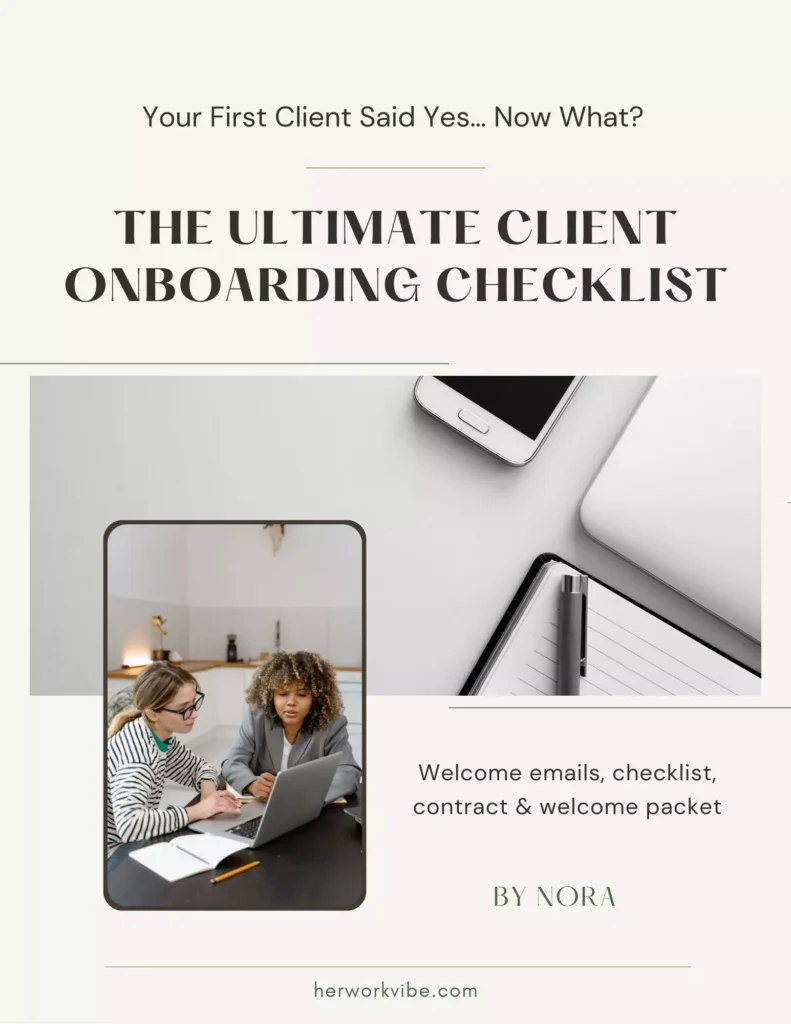
Post navigation
I’ll never forget that feeling. The email notification lights up your phone: “You’re hired!” Your heart does a little jump. You did it! All the work on your resume and portfolio paid off.
And then, about five seconds later, a wave of cold panic hits: “Oh my gosh. Now what do I actually do?”
If you’ve ever felt this, you’re not alone. The moment after landing a client is often more terrifying than the search itself. But here’s a secret: what you do in the first 48 hours after a “yes” sets the tone for the entire project.
Grab your coffee — we’re diving in. This is your ultimate client onboarding checklist to onboard your new client like a seasoned expert, ensuring your first project is smooth, professional, and stress-free.
Why a Great Onboarding Matters (It’s the Foundation of Your House)
Think of your freelance client onboarding like building a house. A proper onboarding process is the solid foundation. Without it, cracks appear later: miscommunication, scope creep, late payments, and constant stress. With a strong foundation, you build a relationship based on trust, clarity, and mutual respect from day one. It’s the difference between a one-time gig and a long-term partnership.
👉 And if you’re still working on landing that first client, my guides on How to Create a Freelance Portfolio From Scratch and How to Write a Freelance Proposal will help you get there.
The Ultimate Client Onboarding Checklist: From “Yes” to “Wow”
Here are the essential steps to follow every single time you start with a new client.
Step 1: The “Make it Official” Phase (Contract & Invoice)
This is the first and most critical step. Never, ever start work without these two things. This isn’t about distrust; it’s about being a professional business owner.
1. Sign the Contract
Always have a written agreement, even for a small project. It should clearly outline the scope of work, deliverables, timeline, payment terms, and revision rounds.
✨Pro-Tip:
You don’t need an expensive lawyer at the start. Use a trusted online tool. Services like Dropbox Sign, PandaDoc, or Bonsai offer customizable, legally-vetted contract templates specifically for freelancers.
2. Send the First Invoice
For new clients, it’s standard practice to request a deposit (typically 30-50%) before you begin any work. This secures their commitment and improves your cash flow. Send the invoice immediately after the contract is signed using a professional tool like Wave (free), PayPal, or Wise.
Step 2: The “Welcome Aboard” Phase (Welcome Email & Asset Gathering)
This is where you make your client feel seen, heard, and confident in their decision to hire you.
1. Send a Warm Welcome Email
As soon as the contract is signed (in first 24 hours), send a personalized welcome email. Restate how excited you are to work together and clearly outline the next steps so they feel guided.
2. Request All Necessary Assets
In the same email, provide a clear, bulleted list of everything you need from them to get started. This might include:
- Brand guidelines (colors, fonts, logos).
- Login details for relevant platforms (social media, website backend, etc.).
- Examples of past work or styles they love.
3. Provide a “Welcome Packet”
This is my secret weapon. It’s a simple PDF document (created in Canva!) that acts as a “user manual” for working with you. It includes your office hours, preferred communication channels, project timeline, and answers to common questions.
Step 3: The “Get Aligned” Phase (The Kick-Off Call)
This is a short (20-30 minute) video call to officially start the project and ensure you’re both on the same page.
Key Agenda Points:
- Recap the Goals: Re-state the main goal of the project and ask, “What does a ‘home run’ for this project look like in your eyes?”
- Confirm the Scope: Verbally confirm what you will deliver and, just as importantly, what is not included to prevent scope creep later.
- Review Communication Rules: “You can expect a weekly update from me every Friday morning via email. Is that best for you?”
- Questions & Next Steps: Give them a chance to ask questions and end the call by confirming your first task.
Step 4: The “System Setup” Phase (The Shared Workspace)
This is where you show off your organizational skills.
1. Create a Shared Hub
Set up a dedicated, shared workspace for the project. This could be a Trello board, a Notion project page, or a simple Google Drive folder. Name everything clearly and logically.
👉 Stay organized with tools from my productivity tools list.
2. Organize Your Internal Files
On your own computer or cloud storage, create a main folder for the client with subfolders like Contracts, Invoices, Client Assets, Deliverables. This saves you from future chaos.
✨Nora’s Pro Tip:
“This step feels like extra work, but it prevents a hundred ‘Where is that file?’ emails later. It’s a vibe-saver!”
Step 5: The “Build Momentum” Phase (The First Small Win)
Your first deliverable is critical for building trust right away.
The Goal:
Choose a small, visible first task that you can complete perfectly and deliver on time (or even a day early).
The Message:
When you deliver it, send a clear, concise email:
“Hi [Client’s Name], just letting you know I’ve completed the first task: [Task Name]. You can find it in our shared Google Drive folder here: [Link]. Please let me know if you have any feedback. I’ll be starting on [Next Task] tomorrow.”
Common Onboarding Mistakes to Avoid (Trust me on this!)
1. Jumping Straight into Work Without a Contract: This is the #1 mistake that leads to scope creep and payment issues.
2. Not Asking for Upfront Payment: This can be a red flag for non-serious clients.
3. Saying “Message Me Anytime”: This is a recipe for burnout. Setting clear communication boundaries is not rude; it’s professional.
4. Delivering Too Much Too Soon: Overwhelming the client with too much information or work at the start can be just as bad as delivering too little. Follow the process.
👉 If you’re struggling with boundaries, my article on Work From Home Challenges Moms Face has practical tips.
Conclusion
You’ve got this, Vibe-Mama! Landing the client was the hard part. Now, with this checklist in hand, you’re equipped to handle the onboarding process like the professional you are.
Take a deep breath, follow these steps, and remember — every successful freelancer started exactly where you are right now. This is your moment to shine.
✨No stress, just vibes!
P.S. Looking for more ways to grow your freelance business? Check out my list of profitable business ideas for moms to explore your next venture!
✨ Want to explore more tips and resources for work-from-home moms?
Browse my blog categories or save this article for later!




useful detailed info, thanks. it’s really important to give a professional impression